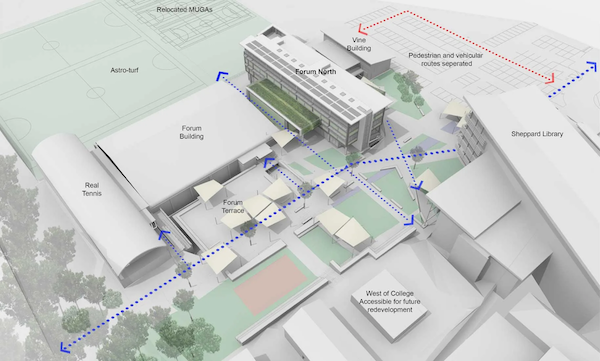Read the latest CAD management information
Your source to articles and resources that can help you be a more effective, and more highly valued CAD manager. Highlighting CAD manager guru, Robert Green. PLUS... CAD programming tips from Andrew G. Roe.
Looking for the latest on CAD software for architecture, infrastructure, and construction? Start here!
From the Editors of Cadalyst

Architecture, Engineering, and Construction (AEC) industries require precision, efficiency, and flexibility in design processes. Computer-Aided Design (CAD) software is indispensable in these fields and enables professionals to create detailed, scalable models. These software programs facilitate everything from drafting and modeling to visualization,simulation, and project management, making them crucial for modern AEC projects.
AEC CAD software serves multiple functions:
When choosing an AEC CAD software, engineers, designers, and drafters will consider these essential features:
AutoCAD is one of the most well-known CAD tool, renowned for its toolset, extensive library of digital models, powerful drafting capabilities, and its customizability. It supports a wide array of customization options through its extensive API (application programming interface) and offers specialized toolsets for different AEC applications, including civil, electrical design, and 3D modeling. Find out more about the latest AutoCAD version here.

The AutoCAD Assistant offers a conversational AI that can offer you AI-generated support and solutions as you work. Image source Autodesk.
Revit, also from Autodesk, is designed specifically for BIM (building information modeling), an essential feature in modern AEC projects. It focuses on architectural design and construction documentation, supporting collaborative work across disciplines in real-time, enhancing project efficiency. The company states that with Revit, users can “model shapes, structures, and systems in 3D with parametric accuracy, precision and ease. Streamline project management with instant revisions to plans, elevations, schedules, sections, and sheets. Plus, unite multidisciplinary project teams for higher efficiency, collaboration and impact in the office or on the construction site.”
Autodesk’s AEC Collection are available as bundles and include AutoCAD, Revit, Civil, Autodesk Forma, Autodesk Docs, and more.
MicroStation is Bentley Systems flagship CAD program which offers design, modeling, simulation, and project documentation tools. Users can develop models in real-world context with a variety of 3D modeling tools. Plus, build and edit curve, surface, mesh, feature, and solids models. MicroStation enables you to develop and document improved designs by connecting you to drafting and modeling capabilities, contextual geospatial data, and design, digital, or review teams.
Bentley is also known for its infrastructure software, such as OpenRoads, OpenBridges, and more. Each year, Bentley holds its Going Digital Award in Infrastructure at its Year In Industry tradeshow. Here the company highlights designs from around the world that push the boundaries of the company’s software.
ArchiCAD is a BIM CAD software that facilitates real-time updates and collaboration,. Graphisoft’s product lineup includes Archicad 27, DDScad 19, BIMcloud and BIMx. Archicad 27 is the company’s design program, which offers a new integrated design option management capability that allows architects and teams to evaluate and communicated design ideas to each other and customers. The company also states that this upgrade increased team efficiency and consistency. It offers new productivity tools, such as distance guides for placing elements.
The company’s DDScad offers MEP (mechanical, electrical, and plumbing) design tools, integrated calculations, and documentation solutions for all building systems.
BIMcloud is the company’s collaboration program helping project team members collaborate on any size project, where they are located, or speed of internet connection. Private and public cloud configurations on standard hardware and Software as a Service (SaaS) allow smaller offices to take advantage of fast, efficient, and secure access to shared projects in real-time, according to the company. The latest innovations focus on security — a key concern of all design firms — thanks to the recently introduced multi-factor authentication. And, BIMx is a presentation and coordination app for any device.
The company offers a subscription-based combination of Archicad, BIMx, and BIMcloud SaaS, Archicad Collaborate.
Vectorworks from Vectorworks, Inc., part of the Nemetschek Group, offers a suite of products that cater to different needs within the AEC community, including landscape, spotlight, and architect versions, each with specialized tools to enhance project-specific outcomes. Vectorworks Architect is a BIM software that gives you tools for conceptual design, site planning, and analysis all in one place, and the program is powered by SIEMENS Parasolid. It allows for “what if” scenarios so designers can analyse designs, plus automate schedules, calculate costs, and analyse energy efficiency. Vectorworks has direct links to OpenBIM, IFC, Revit, SketchUp, Rhino, Photoshop and Cinema4D.

The Titterman Building. Image source: BPR Architects and Vectorworks.
Chief Architect is specialized for residential sector professionals, focusing on home design with automated building tools to create construction documents, site plans, and landscaping plans. Chief Architect Premier is built for for all aspects of residential and light commercial design. As you draw walls and place smart architectural objects like doors and windows, the program creates a 3D model, generates a materials list, and with the use of powerful building tools, helps produce construction Documents with site and framing plans, section details, and elevations.
While SketchUp from Trimble is more commonly associated with preliminary 3D modeling and visualization, it’s widely used in the AEC community for its ease of use and extensive plugin ecosystem. Users can create on the desktop, iPad, and web applications, plus use collaboration tools via the cloud. Stakeholders can view designs using 2D plans, 3D walkthroughs reality viewing, and more. There are a variety of extensions you can take advantage of, including 3D Warehouse (access to millions of pre-built 3d models), Sefaira (early performance analysis), V-Ray (create realistic visuals), and more.
For professionals in the AEC industry, staying informed about and adept with these tools can dramatically increase the efficiency, accuracy, and success of their projects. Whether you are working on a small residential building or a large infrastructure project, the right CAD software is out there to help you achieve your design and construction goals.
Building Information Modeling (BIM) is a technology that has revolutionized the way buildings, infrastructure, and utilities are planned, designed, constructed, and managed. It's also become interlinked with the term digital twin. BIM extends beyond traditional 2D drafting methods (like plans and elevations) by incorporating 3D modeling and real-time management of information throughout the lifecycle of a project.
Definition of BIM. BIM is an intelligent, model-based process that gives AEC professionals the insight and tools to plan, design, construct, and manage buildings and infrastructure more efficiently. It's characterized by the creation and use of coordinated, consistent, computable information about a building project in design and construction.
Key Features of BIM
3D modeling: Unlike traditional drafting, BIM involves creating digital 3D models that represent the physical and functional characteristics of a facility. These models serve as a shared knowledge resource for information about a facility, forming a reliable basis for decisions during its lifecycle.
Interoperability: BIM software supports various functionalities which allow for the integration of different aspects of the design process. This includes the integration of structural, architectural, mechanical, electrical, and plumbing (MEP) designs into one unified model.
Simulation and Visualization: BIM tools allow for the simulation of construction processes and building operations. This capability helps in visualizing potential problem areas, optimizing schedules, and analyzing project complexities.
Documentation: Automated generation of construction documents and schedules, material specifications, and cost estimates based on the BIM model. This leads to more accurate projections and manageable project timelines.
Facility Management: Post-construction, BIM models are used to assist in the operation and maintenance of the facility. This includes management of space, assets, preventive maintenance scheduling, and life-cycle management.
Conclusion
BIM is not just software but a process that encompasses the creation, use, and information management of a BIM model. It represents a shift in the AEC industry, offering a comprehensive approach to design and construction that enhances transparency, efficiency, and collaboration. As the industry continues to evolve, BIM adoption is becoming a standard, driven by its capacity to integrate complex project data into a unified, accessible model. For AEC professionals, mastering BIM tools and processes is crucial for staying competitive in a rapidly changing landscape.
GIS technology integrates with CAD to provide spatial context to building projects. This integration helps professionals in planning and designing by considering geographical data, which is crucial for large-scale projects like urban planning and landscape architecture, and infrastructure planning..
Cloud-based CAD systems are becoming increasingly popular due to their ability to enhance collaboration across different geographic locations. They allow for real-time updates, secure data storage, and access from any device, which significantly streamlines project workflows. With more of our employees working from home, it has become imperative that programs have a cloud option.
AR and VR in AEC help stakeholders visualize projects in a simulated environment, which can be pivotal during the design, client presentations, and review stages. These technologies allow for immersive walkthroughs and can help detect design conflicts early, potentially saving costs and time.
Increasingly, AEC projects are focusing on sustainability. Energy modeling and sustainable design tools integrated within CAD software can predict energy use and model different scenarios to optimize the environmental footprint of a project. There is a growing demand for green building practices and certifications such as LEED.
AI and ML are playing a significant role in transforming AEC through predictive analytics and intelligent automation. These technologies can forecast project risks, analyze data, optimize resource allocation, and even automate certain design aspects to improve efficiency and reduce errors.
IPD is a project delivery approach that integrates people, systems, business structures, and practices into a process that collaboratively harnesses the talents and insights of all participants. This optimizes project results, increases value to the owner, reduces waste, and maximizes efficiency through all phases of design, fabrication, and construction.
Modular construction and prefabrication are becoming more prevalent as methods to speed up construction processes and reduce costs. CAD software specifically designed to support modular construction can help in designing prefabricated components that are built offsite and assembled on location.
Autodesk’s Informed Design is one example of this type of software bringing manufacturing-type thinking into the AEC world.
Note: This article pulls together a broad range of information from Cadalyst.com articles. Click on the linked topics for full discussion.
Your source to articles and resources that can help you be a more effective, and more highly valued CAD manager. Highlighting CAD manager guru, Robert Green. PLUS... CAD programming tips from Andrew G. Roe.